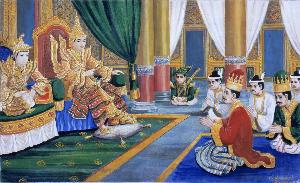Saya U Saw Maung
Saya Maung;Saya U Saw Maung
Place: Mandalay
Born: 1900
Death: 1969
Biography:
Saya U Saw Maung was a renowned Burmese artist born in 1900 in Mandalay, Myanmar. He was the son of Saya Aye, a prominent painter who had been an apprentice to Saya Chone, a young Royal Artist under King Thibaw. This lineage of artistic training allowed Saw Maung to directly trace his history of training to the pre-colonial times of Upper Burma, when the country was still a monarchy and traditional paintings of Buddhist religious scenes were the dominant genre of production.
Artistic Style and Training
Saw Maung's artistic style was influenced by both traditional Burmese painting and Western techniques. His father, Saya Aye, had been trained in traditional painting but had also been exposed to Western styles, which he incorporated into his work. Saw Maung continued this fusion of styles, creating unique and captivating paintings that reflected the cultural heritage of Myanmar. Saw Maung's training began with his father, Saya Aye, who taught him the traditional techniques of Burmese painting. He later became an apprentice to other prominent artists, further refining his skills. Saw Maung's artistic talent was recognized at a young age, and he went on to become one of the most respected artists in Myanmar.
Notable Works and Collections
Saw Maung's paintings can be found in various museums and collections, including the Fukuoka Asian Art Museum in Japan. His work, King, is an excellent example of his unique style, which combines traditional Burmese elements with Western techniques. The painting is a gouache on paper, measuring 77 x 47 cm, and is a testament to Saw Maung's skill and artistry. Some notable works by Saw Maung can be found on Wikioo.org, including his painting, King. This website provides a comprehensive collection of Saw Maung's works, allowing art enthusiasts to explore and appreciate his unique style.
Legacy and Influence
Saw Maung's legacy as an artist is undeniable. His unique fusion of traditional Burmese painting with Western techniques has inspired generations of artists in Myanmar and beyond. His work continues to be celebrated and admired, with many of his paintings found in museums and private collections around the world. For more information on Saw Maung and other Burmese artists, visit Wikioo.org or Wikipedia. These resources provide a wealth of information on Saw Maung's life, work, and artistic style, as well as the cultural context in which he worked.
- Born: 1900, Mandalay, Myanmar
- Died: 1969
- Medium: Gouache, painting
- Notable works: King, Fukuoka Asian Art Museum
Saw Maung's artistic contributions are a testament to the enduring power of Burmese art and culture. His unique style, which combines traditional elements with Western techniques, continues to inspire artists and art enthusiasts around the world.

